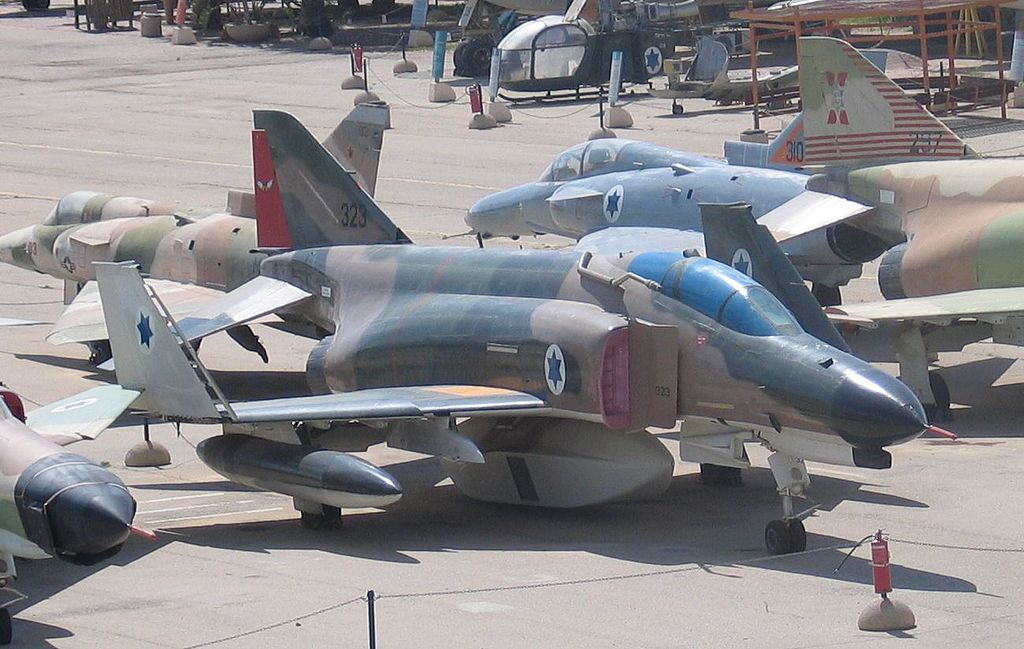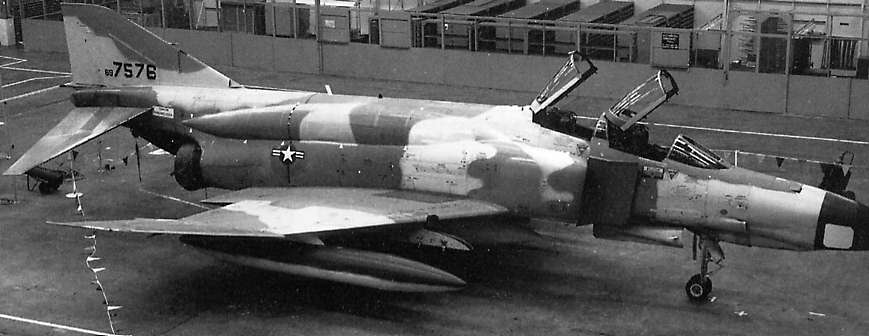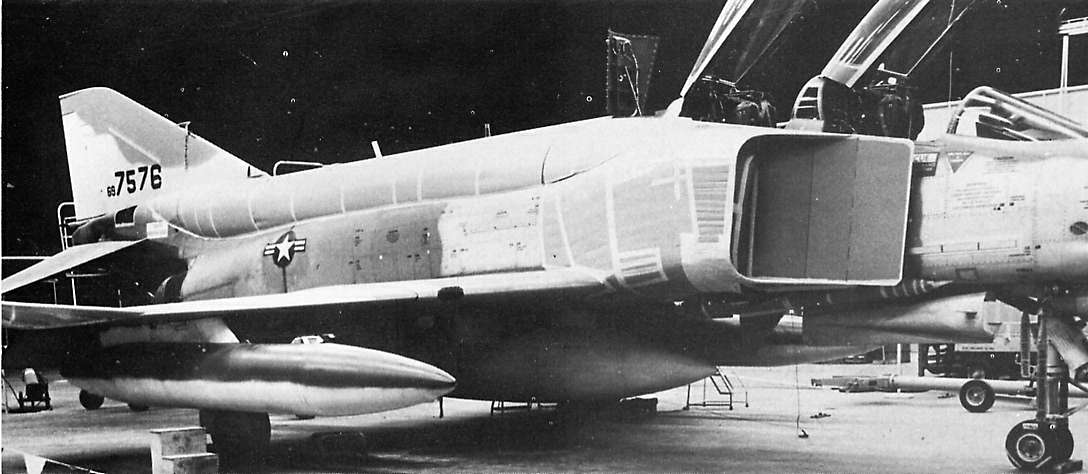The F-4X would have had an increase in engine thrust of 150%, allowing it to cruise at Mach 2.4, reach altitudes of 78,000 feet (23,775 meters), and reach dash speeds of Mach 3.2
The McDonnell Douglas F-4E Phantom II, which Israel purchased in 1969, immediately established itself as the mainstay of the Israeli Air Force (IAF) due to its payload, range, and bombing precision.
In addition to ordering several RF-4s, the IAF also ordered F-4Es. The service reconnaissance assets were pleased to have these aircraft. They were able to fly more sophisticated missions with less risk to people and equipment than had been conceivable with the Mirages and Vautours thanks to their speed, range, and superior camera systems.
The Israel Air Force (IAF) was only the second customer for the RF-4, and these were the first to be outfitted to operate with AIM-9 missiles for self-defense, employing wing pylons with twin launchers, while also maintaining the bombing systems, as Bill Norton explains in his book Air War On The Edge: A History of the Israel Air Force and its aircraft since 1947. The IAF reconnaissance Phantoms were outfitted with the aft fuselage ejector systems for photo-flash cartridges to be employed during night missions, as is typical with RF-4s. The majority of the F-4 squadrons were split up among the reconnaissance aircraft.
According to Norton, “during the War of Attrition recce aircraft were important assets in keeping track of the Egyptian missile boxes and locating targets for follow-up strikes. Photo reconnaissance was especially critical immediately following the War of Attrition. The cease-fire terms required that Egypt freeze its missile batteries in place, and not continue to move SAM boxes closer to the Canal. These terms were very important to Israel, and very hazardous recon flights were made to verify compliance and then monitor movement when the cease-fire terms were clearly violated. Flights into the area were made at 600kts and at such a low altitude that the major hazard was from bird strikes and hitting fishing boat masts.”
The RF-4E aircraft, which the IAF had ordered, did not start to arrive until February 1971, and they did not fly their first mission until March 9. Two IAF F-4Es (coded 17 and 19) were locally modified in a two-month crash program to install a camera in the nose to assist the service in doing this crucial mission. Either a Fairchild KA-52 low-altitude panoramic camera or a Zeiss RMK 15/23 medium-altitude mapping camera could be carried by removing the cannon and making appropriate environmental and electrical changes.
On March 24, 1970, these two aircraft started performing operational duties at 69 Squadron. By September, they had transferred to 201. The rumors that the United States loaned Israel two RF-4Cs as part of Operation Night Light (or Peace Night Lite) between August 1970 and March 1971 may have originated from this IAF initiative, for which Israel allegedly paid $143,000. They were operated by 69 Squadron during their short stay.
As Norton says “it has been suggested that Israel had much earlier exposure to the RF-4. One source asserts that the crews and aircraft of the USAF 38th Tactical Reconnaissance Squadron were deployed from Spain to Israel – probably Hatzerim – to provide their services during the Six-Day War. The RF-4Cs were supposedly given IAF markings and operated in the area until Jun. 12. While the American administration had certainly begun to lean towards the Israeli side in the Middle East conflict by 1967, this kind of material assistance during wartime was very unlikely. The IAF could certainly have used the help, freeing up their recon planes for strike missions. Another book records an even more unlikely event in 1962 when what may have been Israeli pilots collected a number of USN F-4Bs at Wheelus AB in Libya and flew them to an undisclosed location in the east. There has also been an extraordinary claim made that the U.S. Navy provided carrier landing training in the Red Sea to some 100 IAF F-4 aircrew in 1971.”
Shortly after, the SAM batteries were seen being shifted forward. However, due to the potential repercussions of resumed hostilities, neither the United Nations nor the United States, nor even many Israelis, welcomed this news. The United States specifically did not want anything to scuttle the planned Geneva peace talks.
Nothing was done right away. The next summer, two RF-4Es, one piloted by Aviem Sella, flew fast over southern Syria for 20 minutes to get the first clear images of mobile SA-6 batteries. Months of preparation and training went into the mission, which went completely unnoticed by Syrians because it was carried out on a vacation without top cover or ECM. As in October 1971, when an RF-4 returned with an SA-7 lodged in one engine, the risks of such operations were evident. The IAF started high-altitude reconnaissance flights with their RF-4s in April 1973, which required the crew to wear pressure suits.
According to Norton, the IAF sought a way to preserve this priceless source of intelligence in the face of growing threats to overflights of target areas since the picture intelligence produced by its high-speed RF-4E aircraft was so crucial. The IAF became interested in Americans’ 1,228lb (557kg) CAI KA-90 HIAC-1 ultra-long focal length (66in or 168cm) Long Range Oblique Photography (LOROP). The Israelis were able to monitor events close to their boundaries without physically crossing the border thanks to this amazing camera’s ability to resolve a 10 in (25 cm) object at a 20 nm range. The American RB-57Fs modified to carry the system were offered to the Israelis in exchange for one or more of them. However, the US rejected these inquiries.
General Dynamics (GD) later created the G-139, a podded 1,500lb (680kg) version of the camera. The camera was housed in a massive pod that was 22 feet (6.7 meters) long and 4,000 pounds (1,814 kilograms) in weight, with the associated environmental control system. The G-139 aircraft were exported to Israel in 1971 after approval from the US Congress; they arrived in October. The G-139 was used on the centerline of the RF-4s and on two F-4Es that had undergone special modifications. It is known that at least 119 Squadron operated it but how long the podded camera operated is unknown.
The IAF considered the system to be quite efficient, but the Phantom’s speed was severely hindered by the drag of the enormous pod, making it impossible to use. According to reports, this can only reach an altitude of 50,000 feet (15,240 meters) and a top speed of slightly about Mach 1.5. More important photos would be possible at higher altitudes, but the decreased performance also put the pricey and special asset in serious danger should an enemy try to intercept it and prolonged exposure to static anti-aircraft systems.
Norton explains: “To answer the limitations imposed by the G-139, GD began work to boost the performance of the F-4 engines with a series of airframe modifications under a program named Peace Jack. In 1971 the Israelis were invited to participate in the American effort. The Peace Jack airframe was initially to have included a radically revised inlet design and special low-drag external ‘saddle’ tanks. The latter, including pumps, were to provide fluid for an engine pre-compressor cooling (PCC) water injection system to cool the intake air and increase overall engine mass flow. The two 2,500lb-capacity (1,134kg) tanks were to be mounted atop the jet, between the inlet ducts and the spine of the fuselage. These changes would, in theory, have increased engine thrust by 15% to allow dash speeds of Mach 3.2, cruise at Mach 2.4, and flight up to 78,000ft (23,775m) altitude. The conceptual aircraft was tentatively identified as the F-4X, but no actual airframe ever bore this designation.
“By 1974 a reduced size and weight LOROP camera had been designed that could be enclosed in a revised F-4 nose cavity lengthened by 12in (30.5cm) for 70ft3 (2m3) of volume. The nose included two windows on the bottom quadrant and two on either side. The entire camera could be rotated to view from any one of these windows. A separate environmental control system in the nose maintained the camera within an optimal temperature range. The design was termed the RF-4X but, again, no actual aircraft was identified with this designation. The IAF provided F-4E 69-7576 in December 1974 to General Dynamics at Fort Worth, Texas, which, over the next five months, served as the basis for a mock-up of the envisioned modifications. The combination was calculated to have allowed a Mach 2.7 cruise speed.”
The USAF had been funding the Israelis up to this time, but it eventually withdrew from the Peace Jack effort. The program would need at least another year to build, but the Israelis were in dire need of a functional HIAC capacity. The saddle tanks and PCC were omitted since the IAF could only afford to pay for the camera installation on its own. The S stands for “Special,” thus this design was given the name F-4E(S). A separate KS-87 vertically mounted camera was introduced by the IAF after the HIAC.
The bulky nose could accommodate a variety of extra optical sensors, and the Air Force undoubtedly created more packages over time. On one or both of the canopy sills was a sight that was used to make sure a photo target was in the cameras’ oblique field of vision. Two other IAF F-4Es (69-7567 and -7570) joined 69-7576 in Fort Worth to undergo modification. The first flight of the F-4E(S) was on Dec. 20, 1975, and the first of three modified aircraft was delivered on Jul. 30, 1976, the rest shortly afterward to 199 Squadron.
In an effort to hide the change, the aircraft’s noses were painted to look as though their black radomes were still there while in Texas. After repatriation to Israel, the (S) planes, according to Norton, were kept under the highest level of security until 1998. The type may have taken on more of an electronic warfare role late in the 1980s and ’90s and is known to have had Elta jammers installed (the EL/L-8230 internal unit having been mentioned).

Photo by Lockheed Martin, Israeli Air Force, and Bukvoed via Wikipedia





